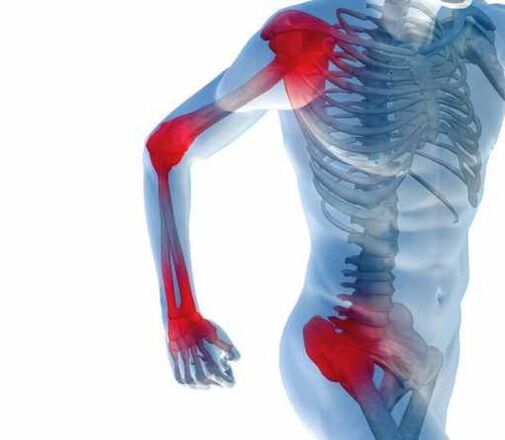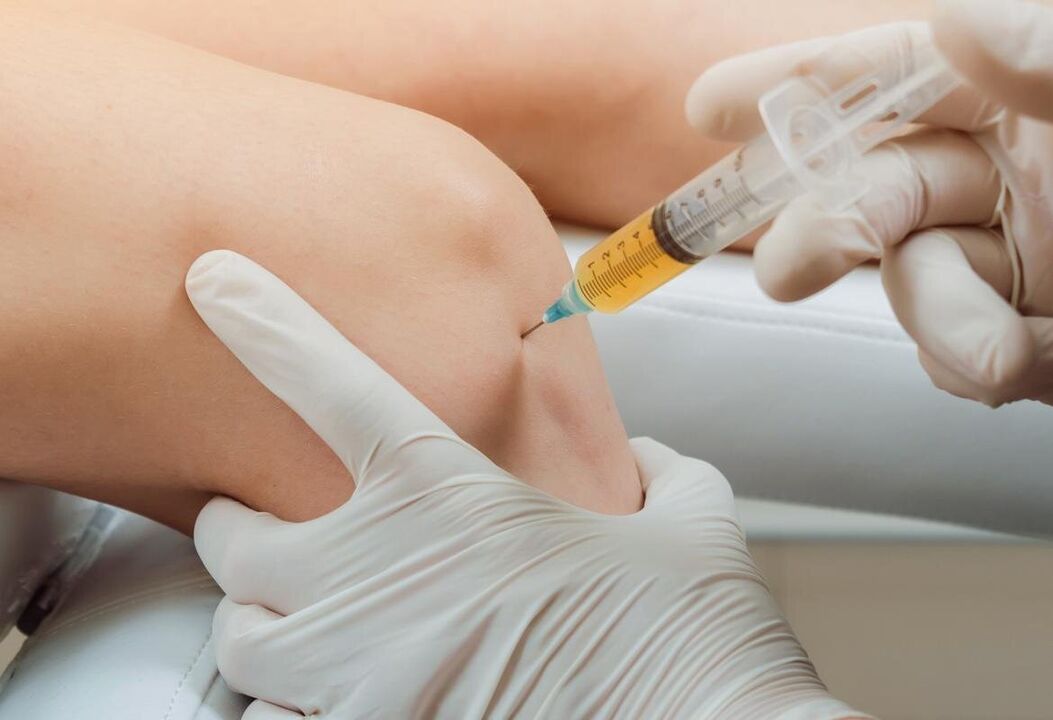
Joint pain(arthralgia) may occur in one or more joints at the same time (polyarthralgia). Arthralgia is observed in rheumatic, endocrine, infectious, neoplastic, neurological, autoimmune diseases, injuries, obesity. Exploring the causes of joint pain is of important differential diagnostic significance; X-ray, ultrasound, laboratory, invasive methods (arthrocentesis, arthroscopy). The treatment of arthralgia is limited to the disease that causes it. Symptomatic measures are used (analgesics, local heat, ointments), immobilization, physiotherapy, surgery.
Classification
They differ in the localization and depth of joint pain, the number of joints involved, the nature and intensity of the pain syndrome, its daily rhythm, the duration of its existence, and its association with certain types of movement. Monoarthralgia is a pain that occurs in one joint, and polyarthralgia syndrome with simultaneous or sequential pain syndrome — oligoarthralgia — involving 5 or more joints.
By the nature of arthralgia syndrome, a distinction is made between acute and dull pain; according to intensity - from weak to moderate to intensive; according to the type of flow - transient and constant. Arthralgia is more common in the large joints - hips, knees, shoulders and elbows, less common in medium and small ones - wrist, ankle, interphalangeal.
The occurrence of joint pain is facilitated by irritation of the neuroreceptors of the synovial membranes of the joint capsules with inflammatory mediators, products of immune reactions, salt crystals, toxins, osteophytes. In rheumatology, the following types of joint pain are usually distinguished:
- acute infections caused by toxic syndrome;
- primary episode or intermittent arthralgia in acute or recurrent arthritis;
- long-term monoarthralgia of large joints;
- oligo- or polyarthralgic syndrome accompanied by involvement of articular membranes or progressive degenerative-dystrophic lesions of the cartilage;
- post-inflammatory or post-traumatic joint pain in the joints;
- pseudoarthralgia.
Why do the joints hurt
Common infectious diseases
Arthralgia syndrome is often accompanied by the course of acute infections. Joint pain occurs both in the prodromal stage of the disease and in the early clinical stage, with fever and intoxication. The infectious form of joint pain is characterized by the "pain" of the joints of the lower and upper extremities, the multi-joint nature of the pain, and its association with myalgia. Mobility is completely maintained in the joint. weakens.
Infectious arthritis
Possible development of reactive arthralgia after infection after acute intestinal or urogenital infections; tuberculosis, infectious endocarditis, parainfection joint syndrome caused by secondary syphilis. Joint pain is often caused by foci of pre-existing chronic infection - pyelonephritis, cholangitis, adnexitis, paratonsillar abscess, or parasitic invasion.
Residual joint pain after arthritis is chronic or transient. Joint pain and stiffness can last for weeks or months; in the future, the well-being and functions of the limbs will be fully restored. Exacerbation of chronic arthralgia is associated with overload, meteorological lability, and hypothermia.

Rheumatic diseases
Poly- or ologarthralgia-type joint pain is a major symptom of inflammatory rheumatic diseases. Rheumatic joint pain is characterized by a syndrome of persistent, intense, migratory pain, large joints, mainly in the lower extremities, and restricted joints.
The debut of rheumatoid arthritis as well as systemic rheumatic diseases is manifested in polyarticular syndrome, which affects small symmetrical joints of the legs and hands, and motor rigidity in the morning.
In microcrystalline gouty arthritis, arthralgia manifests itself in the form of repetitive paroxysmal pains in an isolated joint that suddenly reach peak intensity and do not resolve for a few days.
Degenerative joint lesions
Gradually, prolonged joint pain may indicate deforming osteoarthritis and other degenerative-dystrophic lesions. Involvement of the knee or hip joints is typical in such cases; dull, aching, exercise-related pain types and cessation of their resting state. Joint pain can be weather-dependent, can cause "cracking" of the joints during movement, and can be attenuated with local distraction therapy.
Joint injuries
Bruises, dislocation of the joints, damage to the ligament apparatus, and intraarticular fractures are accompanied by severe pain. The affected joint will swell, deform, become hot to the touch. The supporting function of the lower limb is impaired, the joint becomes more difficult to move, and in some cases abnormal mobility occurs. Injuries can be accompanied by bleeding into the joint cavity, leading to its stiffness.
Oncological diseases
Prolonged, persistent oligo- and polyarthralgia, accompanied by "hippocratic fingers" (deformities of the nails and distal wall flames, such as "watch glass" and "humps"), indicates paraneoplastic changes in the joint membranes. In such patients, the internal organs are oncologically. pathology, especially lung cancer.
Endocrine diseases
Common causes of joint pain are endocrine disorders - primary hyperparathyroidism, ovariogenic dysfunctions, hypothyroidism, obesity. Endocrine genesis syndrome occurs in the form of oligoarthralgia, which is associated with ossalgia, muscle pain, pelvic bone and spine pain.
Other reasons
Other possible causes of arthralgia include:
- heavy metal poisoning (thallium, beryllium);
- frequent joint overload or microtrauma;
- long-term drug therapy;
- postallergic reactions;
- goosefoot;
- X-shaped or O-shaped deformation of the limbs;
- pseudoarthralgia simulated by primary ossalgia, neuralgia, muscle pain, vascular pathology, psychosomatic disorders.
Diagnostics
Because joint pain is only a subjective symptom, clinical and anamnestic characteristics as well as physical examination come to the fore in the exploration of the causes. It is necessary to consult a rheumatologist or orthopedic specialist. To differentiate the etiology of arthralgia, a number of objective studies are performed:
- X-ray of the joints.This is a routine method that allows you to examine the joints for various diseases. Radiography is most often performed in one or two projections, it is possible to study in a special style, and to perform contrast arthrography. A more detailed picture of the condition of the osteochondral and soft tissues of the joints can be obtained by CT and MRI imaging.
- Joint ultrasound.It allows the detection of fluid accumulation in the joint cavity, bone erosion, changes in the joint membrane, and the measurement of the width of the joint spaces. The availability of sonography makes it indispensable in the diagnosis of rheumatoid arthritis pathologies.
- invasive methods.Indications include puncture of the joint, biopsy of the synovial membrane. In disputed cases, diagnostic arthroscopy is performed, which allows the examination of the joint cavity from the inside, and the performance of diagnostic and therapeutic measures.
- Laboratory tests.Helps identify the presence of an inflammatory process,rheumatic diseases. In the peripheral blood, ESR, levels of C-reactive protein, uric acid, specific markers of immunopathology (rheumatoid factor, antinuclear antibodies, ACCP) are determined. An important diagnostic method is the microbiological and cytological examination of synovial fluid.
- Additional diagnostic methods:thermography, podography.

Treatment
Help before diagnosis
For any joint pain, you should stay calm and not strain your limb. The metabolic causes of joint pain require a balanced diet, normalization of weight. In case of fresh injuries, the joint should be applied cold, the injured limb should be fixed with a splint or fastening bandage. You can take painkillers or NSAIDs.
Neglect of competent examination and treatment of joint pain is fraught with the development of irreversible functional disorders of the joints - stiffness, ankylosis, contracture. Because joint pain can be a marker of many diseases, a doctor should be consulted if joint syndrome occurs and persists for more than 2 days.
Conservative therapy
The main role in the treatment of joint pain is given to the treatment of the leading pathology. Medication for arthralgia is aimed at stopping inflammatory intraarticular processes and pain. Systemic therapy involves the use of non-steroidal anti-inflammatory drugs.
In case of moderate joint pain or contraindications to oral administration of drugs, topical topical therapy is performed with warming, anti-inflammatory and analgesic ointments. Applications with dimethyl sulfoxide should be applied to the joint area. Joint gymnastics, physiotherapy procedures (drug electrophoresis, magnetotherapy, phonophoresis, UHF therapy) are recommended.
If necessary, periarticular blockades, intraarticular injections of glucocorticoids, chondroprotectors, and joint fluid prostheses are performed. Modern therapeutic methods for chronic joint pathologies are promising ozone therapy, joint plasma lift and orthokine therapy.
Surgery
Different types of surgery are warranted for joint pain caused by injury and for chronic diseases leading to loss of joint function. They can be performed by open (arthromatomy) or endoscopic (arthroscopy) methods. Depending on the underlying disease, the following will be done:
- arthroplasty;
- arthrodesis;
- ligament plastic;
- rehabilitation of the joint cavity;
- removal of abnormal formations (cysts, intraarticular bodies);
- synovectomy;
- arthroplasty.






















